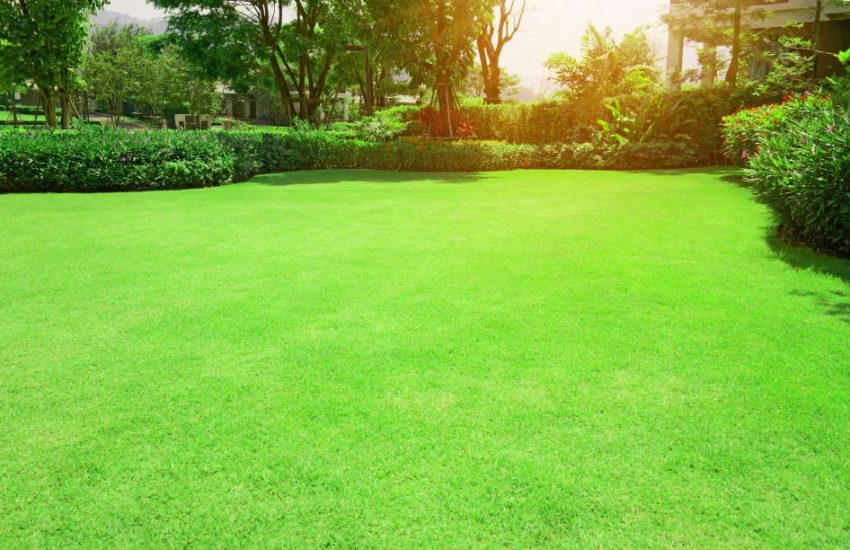15 Ground Cover Plants to Grow in Alabama
Ground cover plants are used to create pathways, prevent soil erosion, and create an interesting and unique landscape. A ground cover plant is any plant that is a low-growing plant that can be utilized to cover a large area, providing carpet-like coverage of the landscape.
Best Time to Plant Ground Cover Plants in Alabama
In Alabama, you should plan to plant your ground cover plants 6 weeks before the first frost of the fall season. Preparing the soil for planting is easy. Simply till the soil in the area where you want to plant/cover, compost, add peat moss, or 3 inches of soil conditioner. You can add fertilizers if necessary, depending on the quality of the soil. After planting your chosen ground cover plant, water thoroughly, and cover with approximately 2 inches of soil.
Alabama has a subtropical climate, meaning the summers are extremely hot and the winters are mild. If you reside in Alabama, it is important to choose ground cover plants that can handle the extreme summer heat.
Best Ground Cover Plants for Alabama Gardens
1. Bugleweed
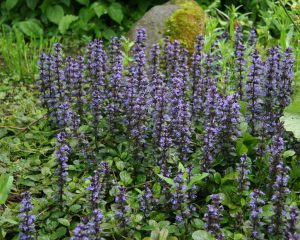
Bugleweed is a creeping perennial that bears blue and purple flowers. Sometimes referred to as ground pine, Bugleweed reaches a height of 4 to 8 inches. The plant tolerates clay and other poor soil types but does best in a moist, rich, well-drained planting site. This plant thrives in partial sun to shade.
As a creeping perennial, Bugleweed will return every year and continue to expand further and further each time it reappears. Bugleweed blooms from May to June, so the best time to plant Bugleweed is 6 weeks before the first fall frost in Alabama.
2. Daylily

Daylilies are flowering ground cover plant that bears orange and yellow flowers. Daylilies most commonly begin blooming in June and July, but there are several varieties of Daylily, some of which bloom earlier. Most Daylily plants will continue to bloom through September, so you will have a beautiful plant in your garden as fall begins. This plant is a perennial that dies in the winter but returns in the spring. If you are planning to plant Daylilies, it is important to provide the plant with full sun for the best growth. Daylilies also reach a height of 24 to 36 inches tall.
3. Dwarf Mondo Grass
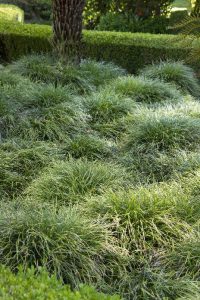
Dwarf Mondo Grass is a smaller version of the popular Mondo Grass plant. This plant typically reaches a height of 4 to 6 inches and 8 inches wide. Dwarf Mondo Grass is perfect for edgeways and pathways but should only be planted in areas where you want full ground coverage. While Dwarf Mondo Grass takes longer to spread than its non-dwarf counterpart, this plant can choke out and overtake other plants. This plant thrives in areas with moist garden soil and filtered sun to full shade. Dwarf Mondo Grass is an evergreen perennial, so it will not die in the winter months.
4. Golden Stonecrop
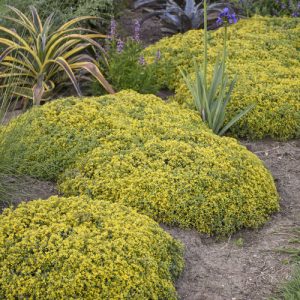
Golden Stonecrop thrives in hot, humid conditions with very little water. This drought-tolerant plant produces small yellow flowers and reaches a height of 4 inches. If you have a problem with weeds, Golden Stonecrop will be a welcomed addition to your garden as it is a weed-smothering plant. Thanks to its high heat tolerance, Golden Stonecrop thrives in full sun and spreads quickly—often spreading 12 plus inches in one growing season. In addition to smothering weeds and tolerating heat, this plant also tolerates foot traffic and poor soil.
5. Shore Juniper

This evergreen plant reaches a height of up to 24 inches. Shore Juniper comes in a few varieties and is a low-growing, dense plant perfect for ground cover. While Shore Juniper does best in full sun, it is also tolerant of shade. Thanks to this plant’s love of the sun, it is drought tolerant. This plant has an average growth rate of 6 to 8 inches per season and takes around 10 years to reach its full size. A full-size Shore Juniper plant is around 24 inches tall and 6 feet wide.
6. Blue Rug Juniper
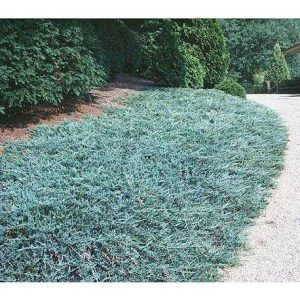
Blue Rug Juniper is another creeping evergreen plant. Unlike Shore Juniper, this Juniper plant reaches a height of 12 inches. Blue Rug Juniper, as the name suggests, creates a rug-like ground cover in your garden. The growth rate of Blue Rug Juniper is 6 to 12 inches per year. The full spread of this plant is 5 to 6 feet upon reaching its full size. Although this is a dense, low-growing plant, it does produce a dark blue fruit.
7. Strawberry Begonia

This plant does do best in partial to full shade, so this is something to consider if your garden doesn’t receive much shade, especially in the summer months. Strawberry Begonia is most commonly planted in flower beds, as borders, in rock gardens, and planter boxes. Strawberry Begonia is a low-maintenance plant that reaches a full size of 6 to 8 inches tall and 12 to 24 inches wide. This plant is a perennial, returning each blooming season, and bears small white flowers in the spring.
8. Creeping Phlox
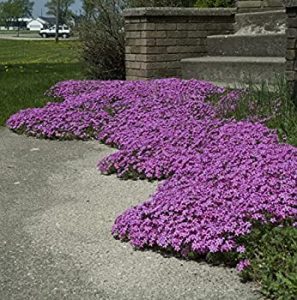
Creeping Phlox is an evergreen perennial that bears flowers in the spring and early summer months. This plant does best in full sun to partial shade, needing around 4 hours of direct sunlight per day. Compared to other ground cover plants, Creeping Phlox spreads at a fairly slow rate of 1 inch per year. Upon reaching full maturity, this plant will be 3 to 8 inches tall and 9 to 24 inches wide. Creeping Phlox is excellent for preventing soil erosion and is drought tolerant when planted in well-drained soil. In addition to being a great ground cover plant, this plant produces flowers in a variety of colors like pink, lavender, white, bluish-purple, and red.
9. Candytuft

Candytuft is a perennial that bears beautiful white flowers in the springtime. This plant prefers full sun but tolerates partial shade. Candytufts have a full size of 6 to 8 inches tall and 12 to 35 inches wide. The growth rate of this plant is moderate, but the plant often requires 5 to 10 years to reach full maturity. Candytuft is a hardy plant but dies back to ground level each winter.
10. Groundcover Roses
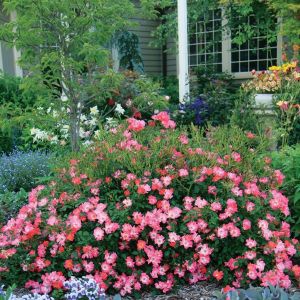
Groundcover Roses are trailing, spreading, perennial shrubs with glossy leaves and prickly stems. A groundcover rose plant can reach 1 to 3 feet in height and around 4 feet in width. These plants, like standard roses, come in a variety of colors, like red, orange, purple, white, pink, and yellow. They require full sun, meaning at least 6 hours of direct sunlight per day. This plant bears flowers from spring to late autumn, but if the plant is not in full sun, fewer flowers will bloom for the season.
11. Spotted Deadnettle
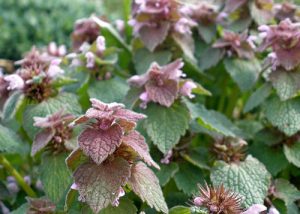
Spotted Deadnettle is a perennial, trailing vine. Spotted Deadnettle, also called Spotted Henbit, grows best in full to partial shade. The plant will not require much water if it is grown in full shade. This, along with its resistance to deer, makes it a prime choice in many gardens. The most common type of Spotted Deadnettle, the Purple Dragon, produces stunning purple flowers. However, the Spotted Deadnettle comes in a few varieties and can bear white, pink, purple, mauve, and pinkish-purple flowers. The Spotted Deadnettle blooms in the late spring, typically from May to June.
12. Southern Shield Fern

The Southern Shield Fern is native to the South Carolina to Florida area of the US. This fern is noted for its bright green arching fronds and resistance to deer. In mild climates, this fern is evergreen. A Southern Shield Fern does best in partial to full shade, growing up to 36 inches in height. The low maintenance of this fern makes it a good choice for many home gardens and landscapes. You will often see the Southern Shield Fern used as ground cover, borders, edgeways, and accents.
13. Monkey Grass

The various types of Monkey Grass fall into 2 categories: Liriope and Ophiopogon. If you are looking for a ground cover plant, you’ll want to select a Liriope type of Monkey Grass. This ground cover form of Monkey Grass prefers full sun to full shade and isn’t picky about soil type. Monkey Grass typically reaches its mature spread, which is 1 to 2 feet wide, within 1 to 2 years. This plant does bear violet flowers. These flowers bloom from July to August.
14. Partridge Berry
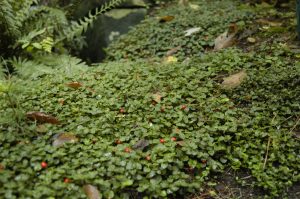
The Partridge Berry plant is an evergreen perennial that produces red berries in the winter months. Partridge Berry is native to North America, growing in the lower 48 states in dry to moist woodland areas. This plant does best in locations with full to partial shade and in undisturbed locations. Partridge Berry is sensitive to disturbances like foot traffic and requires a moist, rich soil environment. This plant grows to a height of approximately 1 to 2 inches and blooms from May through October, bearing white, pink, or purple flowers. The berries from the Partridge Berry plant are edible, although not very tasty.
15. St. John’s Wort
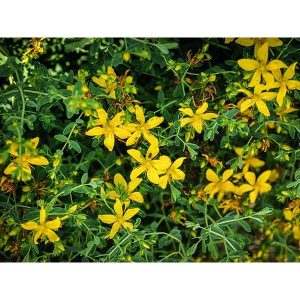
St. John’s Wort, sometimes referred to as Aaron’s Beard, is a creeping semievergreen plant. In early summer, the plant bears yellow flowers that are approximately 2 to 3 inches in diameter. As fall rolls around, the leaves of St. John’s Wort will turn red. St. John’s Wort is a semievergreen plant because, in mild climates, it will last through the winter. Due to the size of the plant, it is not recommended for small gardens. St. John’s Wort reaches a mature size of 12 to 18 inches in height and 24 inches wide. St. John’s Wort prefers full sun to partial shade. The plant does best in well-drained soil and requires an average amount of water.
Bottom Line
If you are planning to vamp up your garden for next spring and summer and reside in Alabama, adding ground cover plants is a great way to do so. The 15 ground cover plants listed above are great options for Alabama gardens.
It is important to select plants whose needs can be met by your climate and current garden. Gardens with more sun will do best with full sun to partial sun thriving plants as opposed to full shade ground cover plants. Additionally, if your garden already has mainly low-maintenance plants, it is best to choose low-maintenance ground cover plants.
No matter which ground cover plant you choose for your garden, you will have a beautiful lush area of ground cover or a gorgeous pathway. Many of these ground cover plants bear flowers in the spring and summer, adding interest to your landscape and garden area. In addition, these gorgeous ground cover plants are perennials, so you will only need to plant them once to enjoy them for years to come.

